Kiteboarding in San Francisco: A Complete Guide
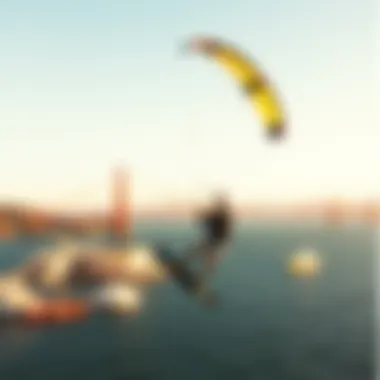
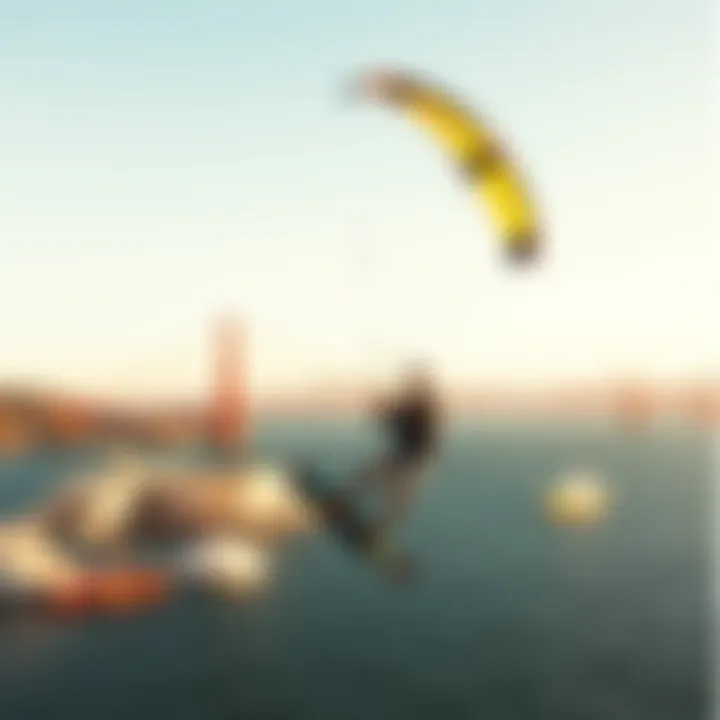
Gear Selection
When it comes to kiteboarding, the right gear can make or break your experience on the water. It's not just about style; it's about safety, performance, and comfort. In San Francisco's varied conditions, knowing how to select the essential equipment can provide a significant edge.
Types of Kites
Selecting the right kite involves understanding the different types available. Broadly speaking, there are two categories to consider: C-kites and Delta kites. C-kites offer great control, making them popular among experienced riders who like to perform tricks. On the flip side, Delta kites provide excellent stability and are typically more user-friendly, catering well to beginners.
- C-Kites:
- Delta Kites:
- Great for experienced riders
- Offers high performance and responsiveness
- Best for beginners
- Easy to launch and land
Whether you’re flying high or just starting out, the material and size of the kite play an essential role. A larger kite can catch more wind, making it suitable for lighter days, while a smaller kite might be advantageous when the winds are howling.
Choosing the Right Board
Once you've got your kite sorted, the next step is to choose a board that matches your skill level and style. Boards typically come in two types: twin-tip and directional. Twin-tip boards are versatile and cater to both freestyle and freeride styles, making them a hit among beginners and intermediates. Directional boards, on the other hand, are designed for wave riding and generally favored by advanced riders.
Consider these factors when picking a board:
- Skill Level: Beginners might lean towards wider twin-tips for stability.
- Weight Consideration: Heavier boards can provide more grip in choppy waters while lighter boards allow for easier jumps.
- Style Preference: Whether you're a freestyle fanatic or a wave rider, your board can greatly enhance your performance.
Skill Development
Gaining proficiency in kiteboarding isn't just about the gear; it's also about building the right skills. Whether you're a fresh face or already know your way around the sport, enhancing your techniques can help you enjoy the thrill of kiteboarding even more.
Essential Techniques
Every kiteboarder must master some core techniques. Starting with the basics, getting comfortable with launching and landing your kite is crucial. This involves not only knowing how to control the kite in the air but also understanding its power zone - that's where the magic happens.
- Control: Keep an eye on the wind shear and how your kite reacts.
- Body Positioning: Your stance can influence your balance significantly; make sure your feet and shoulders align for optimal stability.
Progression Tips
To improve, it’s critical to push the envelope while practicing consistently. Here are some tips:
- Take Lessons: Find a local school such as Kiteboarding School of San Francisco that offers lessons catered to various skill levels. Experienced instructors can provide you with feedback that's invaluable.
- Practice Variety: Mix in different types of terrain and wind conditions to adapt your skills.
- Join Community Events: Engage with local kiteboarding events to learn from fellow enthusiasts and share experiences.
As you sift through techniques and gear, remember that kiteboarding is as much about enjoying the experience as it is about skill.
"In kiteboarding, every gust of wind tells a story. The more you listen, the better you ride."
Beyond practicing your skills, understanding the local environment and conditions in San Francisco can also affect your performance, which is what we'll tackle next!
Intro to Kiteboarding
Kiteboarding, also known as kitesurfing, has surged in popularity across the globe, and San Francisco serves as a vibrant backdrop for this exhilarating sport. A blend of surfing, snowboarding, and paragliding, kiteboarding enables thrill-seekers to harness wind power and glide across water's surface at remarkable speeds. In this article, we’ll explore the ins and outs of kiteboarding, particularly within the unique landscape of San Francisco.
Defining the Sport
At its core, kiteboarding involves riding a board while being pulled by a large, controllable kite. Riders steer the kite using a control bar and harness, which allows for an impressive range of tricks and styles of riding. This sport can vary widely in intensity and approach, appealing to everyone from casual sunbathers taking their first ride to seasoned athletes perfecting advanced maneuvers.
The accessibility of kiteboarding is a key element that draws many to the sport. Each session can be tailored to the rider's skill level and desired experience, whether that means taking it easy and enjoying the scenery or going all out with jumps and tricks.
History and Evolution
The roots of kiteboarding stretch back to the early days of kite flying, though the modern version began to take shape in the late 20th century. In the early 1980s, pioneers experimented with using power kites for water sports, pushing the boundaries of what was possible. Initial developments were basic, with homemade kites and boards oftentimes leading to unpredictable results. However, as technology evolved, so did kiteboarding.
By the 1990s, kiteboarders had started to gain recognition globally, leading to a wave of innovations – including lighter materials, advanced control systems, and more stable designs. From that point on, the sport experienced an explosive growth, capturing the attention of water sports enthusiasts.
Today, kiteboarding isn’t just a mere pastime. It has transformed into a competitive arena, with international championships and communities forming around the globe. Local clubs and events have also sprouted in places like San Francisco, fostering a strong sense of camaraderie among kiteboarders.
In essence, kiteboarding has transitioned from a niche activity to a mainstream attraction, and San Francisco, with its stunning views and favorable climate, is right at the heart of this evolution.
Kiteboarding Locations in San Francisco
When it comes to kiteboarding, location plays a crucial role in crafting the experience of any enthusiast, whether they’re just embarking on this exhilarating sport or are seasoned veterans. San Francisco, with its beautiful coastline and unpredictable winds, provides unique opportunities to catch some serious air while enjoying stunning views of the Bay and the iconic Golden Gate Bridge. In this city, the array of spots catering to kiteboarders presents countless possibilities, with options that range from the bustling launching sites to the quieter, more secluded locations. Understanding these various locales is essential as it helps practitioners choose the right environment for their skill level and preferred riding conditions.
Top Spots for Kiteboarding
Crissy Field
Known for its picturesque scenery and consistently strong winds, Crissy Field is a cornerstone of kiteboarding in San Francisco. This location has become synonymous with the sport due to its expansive beach and waterfront space, which makes it an ideal launch point for kiteboarders. The prime characteristic of Crissy Field is the strong, steady winds that typically blow in the afternoons, providing perfect conditions for those looking to get airborne.
One unique feature of this spot is its breathtaking view of Alcatraz and the Bay; riding here is like being on a postcard. However, it also attracts a plethora of other water activities, which can sometimes lead to crowded conditions, especially on weekends. Kiteboarders need to be aware of their surroundings to ensure a safe ride among fellow water enthusiasts.
Ocean Beach
If you’re after a more rugged, natural experience, Ocean Beach offers an entirely different vibe. Here, the surf can be choppy, adding a layer of excitement to rides. The key characteristic of Ocean Beach is its ability to challenge even the more experienced riders due to its shifting tides and waves. The expansive beach provides ample space for launching but also requires respect for the often strong currents that can occur.
Despite these challenges, many kiteboarders flock to this spot for the surge of adrenaline it offers. One disadvantage, however, is that it can be treacherous for beginners, and the vastness can make it feel isolating at times. Nonetheless, for those craving an adrenaline rush and ready to tackle the waves, Ocean Beach represents a thrilling option.
Treasure Island


Treasure Island is unique in that it combines the appeal of calm waters with spectacular views of both the city skyline and the Bay Bridge. This location is less crowded than others, allowing kiteboarders the luxury of space and time to practice and hone their skills without navigating through throngs of other riders. Its key feature is the consistent wind conditions, which can be less intense than other locations, making it suitable for beginners too.
A unique advantage Treasure Island offers is its sheltered bay area, which results in relatively flat water. This characteristic is perfect for those looking to learn tricks or simply enjoy a more relaxed ride. However, its isolation from more popular spots means that amenities can be limited. It’s advisable for visitors to come prepared or check local resources for comprehensive details.
Hidden Gems
As wonderful as the well-known spots are, San Francisco also hides some lesser-known locations that deserve attention. These might not be bustling with crowds or equipped with ample facilities, but they often provide a more untouched and serene kiteboarding experience. Understanding these hidden gems can enrich your kiteboarding journey through the Bay.
Alameda
Alameda, located a short ferry ride from San Francisco, brings a refreshing atmosphere for those eager to escape the hustle and bustle of the city. The calm bay waters that surround this area make it a favored choice for kiteboarders who prefer to glide smoothly without the interruption of crashing waves or hefty winds.
This spot’s key aspect is that it offers shallow waters, which are incredibly helpful for beginners. As always, it is worth noting that while the conditions may be inviting, kiteboarders should still be cautious of local traffic and respect the space to maintain safety for all enjoying the area. The potential downside is that windy days can be fewer here compared to other more exposed locations.
Kite Beach
Lastly, there’s Kite Beach, which literally lives up to its name. An expansive area, Kite Beach tends to attract kiteboarders from various backgrounds, making it an exhilarating environment for sharing tips and experiences. The winds here are generally reliable, and its prime location near amenities like cafes and rental shops makes it convenient.
A distinctive benefit here is the ability to mingle with a vibrant community of fellow kiteboarders, sharing knowledge and tips. That said, popular spots might mean occasional overcrowding, which can detract from the experience if one is seeking solitude or a more tranquil session on the water.
In summary, whether it’s the iconic views of Crissy Field, the rugged challenges of Ocean Beach, or the serene experience at Treasure Island, kiteboarders in San Francisco have plenty of distinctive locations to choose from. Hidden gems like Alameda and Kite Beach round out the options, making it an ideal city for all levels of kiteboarding enthusiasts.
Understanding Local Conditions
Understanding the local conditions for kiteboarding in San Francisco is paramount for both safety and enjoyment. The unique geographical features of the Bay Area directly influence wind patterns, tides, and currents which are crucial for kiteboarding enthusiasts. Knowing these elements can be the difference between a thrilling ride and a treacherous session. For both learners and seasoned kiteboarders, grasping these locations' nuances not only enhances experience but also ensures safety and effectiveness of practice.
Wind Patterns
When it comes to kiteboarding, wind is your best friend, as long as it behaves. The San Francisco area is known for its distinct wind characteristics, which are influenced by both local geography and seasonal shifts. Generally, kiteboarding is most optimal in the afternoon when the sea breezes kick in, typically starting around noon and often lasting well into the evening.
In the summer, the wind tends to blow consistently from the northwest. These conditions make spots like Crissy Field ideal due to their more reliable winds, with a range of 15 to 30 knots in the peak season. Keep an eye out for shift patterns; if you notice a sudden lull, it often means that a stronger gust is on its way.
Moreover, wind direction plays a critical role. Cross-onshore winds are preferred for both safety and performance while riding. For instance, if you're kiteboarding at Ocean Beach, understanding how winds come across the water—often picking up speed over the shore—can lead to more enjoyable rides with fewer mishaps.
"Always check wind reports and local forecasts before heading out; the unpredictable whims of nature can turn a great day into a risky venture!"
Tides and Currents
Tides and currents are the unsung heroes of a good kiteboarding session, dictating not just the timing, but the dynamics of riding. San Francisco’s tidal patterns are complex due to the Bay’s unique geographical layout. High tide can bring in a larger swell, which some kiteboarders crave for exciting rides, while low tide may reveal rocky areas unsuitable for safe practice.
Understanding currents is equally vital. Notably, areas like Treasure Island can experience strong currents that can catch kiteboarders off guard, especially during peak tide changes. The golden rule is to plan sessions either during neap tides when currents are milder or to choose spots where the effects of currents are minimized.
To get the most out of your kiteboarding experience, familiarize yourself with local tidal charts and schedule your rides accordingly. As a rule of thumb, riding within an hour or two of a tide change can result in advantageous wave conditions for your session.
In essence, knowledge about wind patterns, tides, and currents adds a layer of expertise to your kiteboarding pursuit. Master these aspects, and you will not only ride with confidence but also increase the joy derived from the thrilling experience of being on the water.
Essential Equipment for Kiteboarding
Engaging in kiteboarding is as much about the skill of the rider as it is about the equipment that supports this thrilling sport. Proper gear not only enhances performance but also ensures safety in the unpredictable conditions often found in places like San Francisco. Kiteboarding, with its mix of adrenaline and grace, demands an understanding of essential equipment, making this section particularly important for enthusiasts ranging from novices to veterans.
Kite Varieties
The first piece of gear that often catches one's eye is, without a doubt, the kite itself. Kites come in various styles and sizes, each designed for specific wind conditions and rider preferences.
- Inflatable Kites: These are the most common type found in today's kiteboarding world. Equipped with a bladder that inflates with air, these kites provide excellent lift and stability. Riders often find inflatable kites forgiving for beginners, allowing for easier relaunching after crashes.
- Foil Kites: Made from fabric and designed without a rigid frame, foil kites are lightweight and can offer enhanced performance in lighter winds. They have a more technical setup but are beloved by seasoned riders who appreciate their versatility and efficiency.
Choosing the right kite also takes into account the wind conditions you'll face. Factors like size (measured in square meters) vary according to your weight, experience level, and the usual wind conditions at your chosen spot.
Boards and Harnesses
Once you have the kite sorted, it’s time to consider your board and harness, often viewed as an extension of your body while riding.
- Kiteboards: These typically come in two primary forms - twin-tips and directional boards. Twin-tips are the go-to for most kiteboarders, providing ease of use for tricks and jumps. They can be ridden in either direction, making them versatile for various styles. On the other hand, directional boards, much like surfboards, are ideal for wave riding, offering a different sensation that many find exhilarating.
- Harnesses: The importance of a good harness cannot be overstated. Some riders prefer waist harnesses for their freedom of movement, while others opt for seat harnesses, which offer a more secure fit, especially in challenging conditions. A snug fit is crucial; if it’s loose, you risk losing control, and if it's tight, you may end up feeling sore.
- Material Matters: Boards are constructed from composite materials, and understanding the construction can help you choose one that balances flexibility and rigidity, enhancing your control.
Safety Gear
Lastly but crucially, safety gear is a non-negotiable component of kiteboarding. It protects the rider against unforeseen events, especially in dynamic environments such as those around the San Francisco Bay.
- Impact Vests: Designed to cushion against sudden falls, these vests can prevent injuries from hard landings or collisions.
- Helmets: Helmets shield your head from potential impacts caused by your kite or board. While some might see them as cumbersome, in the thick of it, you'll be grateful for the added protection.
- Safety Leashes: These are essential. They connect your kite to your wrist or waist, ensuring that even in a wipeout, the kite doesn’t drift away powerfully, posing a risk to others on the water.
"In kiteboarding, your gear is your lifeline; choose wisely and maintain it well."
In wrapping this section, it is clear that the right kiteboarding equipment comprises various elements that contribute to an enjoyable and safe experience. Understanding each component can make a significant difference not just in performance but also in the joys of riding the winds around San Francisco. Familiarity with these tools will prepare anyone, beginner or seasoned rider, for the exhilarating water sprays and the challenges that might lie ahead.
Kiteboarding Safety Protocols
Engaging in kiteboarding, especially in a dynamic environment like San Francisco, necessitates a keen focus on safety protocols. These guidelines are not just formalities; they are essential for ensuring not only your well-being but also that of others sharing the waters. The thrill of harnessing the wind can quickly turn into a perilous situation without proper precautions. Understanding the significance of kiteboarding safety is crucial for a rewarding experience on the water.
Personal Safety Measures

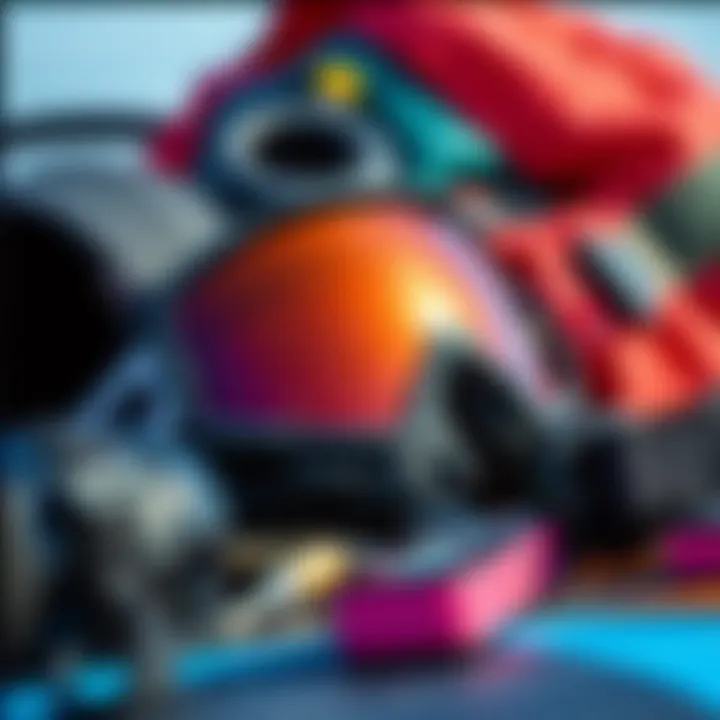
When it comes to kiteboarding, personal safety should be your first priority. Here are some measures every kiteboarder should adopt:
- Wear a Personal Flotation Device (PFD): A well-fitting PFD can significantly increase your safety. Even if you are a proficient swimmer, conditions can change rapidly, and a PFD helps keep you above water.
- Use a Helmet: Falling while kiteboarding can lead to head injuries. A helmet reduces the risk of serious damage. Make sure it’s one designed specifically for water sports. This is an investment in your safety.
- Practice Proper Launching and Landing: Always be mindful of your surroundings. Make sure there is enough space for launching and landing your kite. Enlist a buddy to assist you, or look for designated areas where it's safe to do so.
- Know Your Kite’s Depower System: Familiarize yourself with your kite's features. Understanding the depower system can be a game-changer during strong winds or if you encounter an emergency.
- Take a Safety Course: It can’t be emphasized enough. Enroll in courses that focus on safety protocols and rescue methods. This knowledge not only equips you but also instills confidence in your abilities.
"It's not about how skilled you are; it’s about how safe you can remain while riding."
Environmental Awareness
Kiteboarding is as much about respecting the environment as it is about the thrill of the sport. Being considerate of local ecosystems ensures that this activity remains sustainable for future generations. Here’s what you should keep in mind:
- Avoid Sensitive Areas: Certain locations may be home to marine life – such as nesting birds or critical fish habitats. Know where these areas are and steer clear when kiteboarding. Respecting nature is crucial to preserving it.
- Leave No Trace: Whether it’s trash, equipment, or other debris, maintain cleanliness in your kiteboarding areas. A responsible rider will always pack out what they pack in.
- Educate Others: As part of the kiteboarding community, share your knowledge about environmental care with fellow enthusiasts. The more we know, the better we can protect our playground.
- Stay Informed on Local Regulations: Different regions may have specific rules about kiteboarding. Familiarize yourself with these so you can enjoy your sport while remaining compliant.
- Participate in Clean-Up Events: Engage with local organizations that organize clean-ups or conservation efforts. They often welcome volunteers and provide a fantastic way to contribute positively.
By following these safety protocols, kiteboarders not only enhance their own experience but also contribute to the thriving culture surrounding the sport. Prioritizing personal safety and being environmentally conscious helps maintain the integrity of kiteboarding in San Francisco, ensuring it remains an epic sport for years to come.
Cultural Aspects of Kiteboarding in San Francisco
Kiteboarding in San Francisco is not just a sport; it embodies a lifestyle and reflects the city's cultural tapestry. The unique blend of diverse communities and the exhilarating rush of wind and sea creates a vibrant atmosphere that enriches both participants and spectators alike. Understanding these cultural aspects is crucial for anyone wanting to grasp what kiteboarding truly represents in this picturesque city.
Local Community and Events
The kiteboarding community in San Francisco is a tight-knit group of enthusiasts who share a passion for the ocean and the thrill of the wind. With various skill levels, this diverse community often comes together for local events that foster camaraderie.
Events like the Bay Kiteboarding Championships draw crowds not only to witness the competition but also to celebrate the sport itself. These gatherings provide a platform for kiteboarders, instructors, and spectators to mingle, exchange tips, and share their most memorable rides. Most importantly, they create lasting friendships among individuals who might have otherwise drifted apart in the bustling city.
Moreover, social media platforms like Facebook and local forums on Reddit serve as vital communication channels. Here, locals share their experiences, post about upcoming events, and seek advice about gear, safety, and conditions. Such community interaction ensures that both new and seasoned kiteboarders remain engaged and informed, reinforcing the sport's presence in the cultural landscape of San Francisco.
Influence of Regional Practices
The practice of kiteboarding in San Francisco is deeply influenced by the region’s natural landscapes and cultural dynamics. The bay, with its expansive waters and varied winds, creates challenging yet rewarding conditions that attract riders from all over. This local climate encourages adaptability; kiteboarders learn to read the subtle shifts in wind patterns and tidal movements, a skill essential for safely navigating these waters.
Additionally, the cultural diversity of San Francisco adds another layer to the kiteboarding experience. Influences from surf culture, skateboarding, and even traditional water sports have all seeped into the local approach to kiteboarding. These regional practices not only shape techniques and styles but also enhance the equipment options available in local shops.
Embracing their unique surroundings, San Francisco kiteboarders often advocate for environmental protection and sustainability. The community respects the delicate marine ecosystems and often engages in initiatives like coastal clean-ups, ensuring that the waters they love remain pristine for future generations.
"Kiteboarding is not just about riding the wind; it's about riding the spirit of the community that thrives on the shores of San Francisco."
For additional insights and community interaction, check out forums on Reddit or visit Facebook for local event announcements and tips.
Seasonal Variations in Kiteboarding
Kiteboarding is not just a mere activity; it's an experience that varies significantly with the seasons. Understanding these seasonal changes is crucial for both novices and seasoned riders. The shifts in weather patterns can affect everything from wind strength to water temperature, making it imperative to know when conditions are most favorable. This section dives into the best times to hit the waves as well as the challenges that different seasons may pose.
Best Times to Ride
In San Francisco, the kiting season generally peaks during the summer months, spanning from late May to early September. During this period, the wind patterns are relatively stable and consistent, which is a dream for kiteboarders. Here’s a more detailed breakdown of why this period is so appealing:
- Reliable Wind: The summer months bring along what locals term the "Marine Layer." It results in optimal onshore winds, typically blowing between 15 to 25 knots. These winds are perfect for both beginners and experts alike.
- Warm Water: Although San Francisco's waters are famously chilly, the summer sees a slight rise in temperature. While you may still want a wetsuit, the experience is more enjoyable without the biting cold of winter.
- Social Atmosphere: With more people out kiteboarding, there’s a thriving community vibe that comes alive in the summer. You’re likely to encounter various events and meet-ups, making those rides more of a social occasion.
Seasonal Challenges
However, it’s not always smooth sailing. Each season brings its own quirks and challenges that kiteboarders must navigate:
- Fall: Autumn can be tricky. While the winds can still be good, they often become more variable. Riders may find themselves dealing with sudden gusts and lulls, making for unpredictability on the water.
- Winter: The cold months are generally not favored by most kiteboarders. Wind speeds can drop significantly, and the water temperature plummets. Though die-hard enthusiasts might still venture out, they face the challenge of frigid conditions. Frostbite is a very real concern, as is the reduced visibility from rain and fog.
- Spring: As winter transitions into spring, kiteboarding starts to pick up again but lacks the steadiness of summer. Riders may get a mix of decent winds but must remain adaptable. Spring weather can be capricious, with sudden changes that might leave a kiteboarder soaked or seeking shelter within minutes.
"Knowing the seasonal variations can either make or break your kiteboarding experience—prepare accordingly, and you'll ride the waves with confidence."
Kiteboarding Schools and Instruction
Kiteboarding is an exhilarating sport that combines the thrill of windsurfing and the rush of surfing. For those looking to dive into this high-adrenaline activity, understanding the importance of proper instruction is key. Kiteboarding schools play a crucial role in fostering safe, effective learning environments. Through structured lessons, aspiring kiteboarders gain a solid foundation of skills, from basic techniques to advanced maneuvers.
Moreover, having a certified instructor can significantly enhance safety on the water. These professionals deliver insights not only about the mechanics of flying a kite but also about understanding wind patterns, water currents, and local regulations that can vary from one location to another. Learning from experienced instructors minimizes risks and builds confidence in new riders, making the journey of becoming adept at kiteboarding much smoother.
Finding the Right Instructor
When searching for an instructor, it's essential to know what you truly need from the learning experience. First, consider your current skill level; are you a beginner eager to grasp the basics or perhaps an experienced rider wanting to polish specific skills? Many kiteboarding schools have instructors specializing in various areas, ensuring a tailored approach.
Some factors to consider when selecting an instructor include:
- Certification and Experience: Ensure they are certified by reputable organizations such as the International Kiteboarding Organization (IKO). A qualified instructor brings credibility and a wealth of knowledge.
- Teaching Style: Every instructor has a unique teaching method. Attend a trial lesson or read reviews to find someone whose style resonates with you. A good connection can make the learning process far more enjoyable.
- Communication Skills: Look for someone who can explain concepts clearly and help you grasp the technical aspects of kiteboarding without feeling overwhelmed.
- Safety Awareness: An emphasis on safety should be paramount. Your instructor should demonstrate a thorough understanding of water safety and protocols.
Finding the right instructor can be transformative; with the right guidance, you can avoid common pitfalls and embark on an enriching journey in kiteboarding.
Recommended Schools in San Francisco
San Francisco boasts various kiteboarding schools catering to all skill levels. Here's a look at some authoritative schools known for their excellent instruction and well-structured programs:
- Kiteboarding School San Francisco: Located near Crissy Field, this school offers hands-on lessons with certified trainers. They provide customized packages that cover everything from beginner lessons to advanced training.
- Adventure Sports Kiteboarding School: With experienced instructors and a range of equipment, Adventure Sports excels at fostering confidence in their students. Their well-established reputation stems from years of dedicated kiteboarding education.
- Water Warriors: Based towards the Bay Area, they focus on providing personalized instruction and ensuring that safety remains a top priority. They also often organize community events, enhancing the social aspect of kiteboarding.
These schools not only equip you with essential skills but also connect you with a community of like-minded enthusiasts, making your venture into kiteboarding not just a sport but a lifestyle.
"Learning to kiteboard is like learning to dance with the wind—find the right partner, and you’ll soar!"
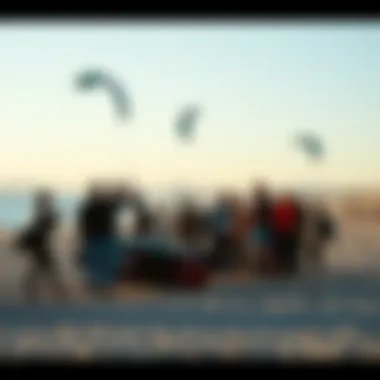
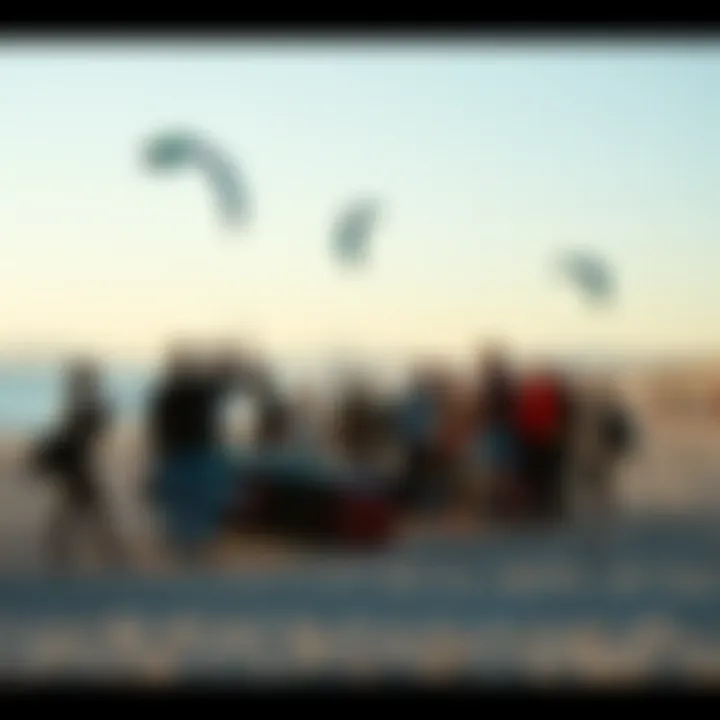
By investing time and resources into quality instruction at these schools, you're taking the first, and often most important, step towards mastering the art of kiteboarding.
Environmental and Ethical Considerations
Kiteboarding is not just a thrilling sport; it sits at the crossroads of enjoyment and responsibility. As enthusiasts flock to the waters of San Francisco, understanding the environmental and ethical implications of kiteboarding becomes increasingly essential. The delicate balance between having fun on the water and preserving the coastal ecosystems we enjoy is crucial for sustainability and future generations of kiteboarders.
Sustainability Practices
Kiteboarders have a particular obligation to practice sustainable habits to minimize the impact on natural resources. These practices include:
- Choosing Eco-Friendly Gear: Many brands now offer kiteboarding equipment made from recycled materials. Opting for brands that prioritize sustainability can help reduce waste.
- Respecting Local Guidelines: Each location has its own set of rules regarding kiteboarding. Following these regulations is important not just for legal reasons but for the collective health of the environment.
- Participating in Clean-Up Events: Several local organizations host river and beach clean-up days. Getting involved can, as the locals say, help keep our waters clean and beautiful.
- Educating Others: Whether you’re sharing on social media or chatting with fellow riders, raising awareness of sustainable practices helps foster a responsible community.
Effectively employing these practices can help protect the stunning natural landscapes of San Francisco, ensuring that kiteboarding continues to thrive without compromising environmental health.
Protecting Marine Ecosystems
The waters off the coast of San Francisco are rich in biodiversity and are home to countless marine species. Kiteboarding can disrupt these ecosystems if not performed with care. Here’s how to help:
- Avoiding Wildlife Areas: Steer clear of areas where marine animals congregate, particularly during breeding seasons. This protects delicate habitats and minimizes disturbances.
- Using Responsible Launch and Land Areas: Always launch and land your kite in designated areas, preventing damage to shorelines and habitats. This keeps both the environment and the sport accessible for everyone.
- Educating Yourself on Local Species: Knowing which species are present and vulnerable in the waters you are riding in can help you avoid any habitat disruptions. Familiarize yourself with local sea life and how they may react to your kiteboarding activities.
- Carbon Footprint Awareness: Mindfully considering how gear is transported and the overall carbon footprint in kiteboarding activities contributes to longer-term sustainability. Ride local when you can, and support eco-tourism ventures.
"Protecting our marine ecosystems ensures the future of kiteboarding for generations to come. If we act now, we preserve not just the sport, but the beauty of our oceans and sky."
Making a conscious effort to protect marine ecosystems while kiteboarding not only showcases respect for nature but also enhances the relationship between riders and their environment. Remember, a clean and thriving ocean is the playground for all kiteboarders, and it’s our responsibility to ensure it remains so.
Navigating Regulations and Local Policies
Kiteboarding is a thrilling ocean sport that attracts adventurers and enthusiasts alike. However, the enjoyment derived from riding the ocean waves comes with its set of regulations and local policies aimed at ensuring safety, preserving the environment, and maintaining harmony within the community. Understanding these regulations is crucial because they determine where and how kiteboarding can be practiced safely and responsibly. Ignoring local laws can not only lead to fines but also to the degradation of the sport's image in the community.
Understanding Local Laws
Local laws regarding kiteboarding can vary from one area to another. In San Francisco, these regulations are largely governed by both city ordinances and state laws focused on water safety and environmental protection. Each kiteboarding location may have its own specific set of rules. For instance, certain beaches might restrict kiteboarding during peak hours to minimize risks to swimmers and beachgoers.
Some key considerations include:
- Hours of Operation: Many locations have designated times for kiteboarding to prevent conflicts with other recreational activities.
- Designated Areas: Kiteboarders are often required to use specific areas for launching and landing kites to ensure safety for everyone near the water.
- Safety Equipment: Some laws may require kiteboarders to have certain safety gear on hand, like life jackets or signal flags, especially in areas with heavy current.
Additionally, it’s important for kiteboarders to stay abreast of any changes in local regulations. A wise move is to visit the local government or park service website, typically domains, to find the latest updates. This proactive approach not only keeps enthusiasts informed but also demonstrates respect towards local authorities and fellow water users.
Navigating Permit Requirements
When it comes to kiteboarding in San Francisco, navigating permit requirements can be somewhat of a minefield. While some locations may not require permits, others certainly do, especially if one intends to hold events, competitions, or special demonstrations. Obtaining the necessary permits is vital for several reasons:
- Legality: Kiteboarding without a proper permit could result in fines or having the activity banned altogether.
- Insurance: Certain permits may mandate proof of insurance. This is crucial should an accident occur, protecting both the organizer and participants.
- Planning and Coordination: Securing a permit can aid in organizing events more smoothly, minimizing disruptions and ensuring that all safety protocols are in place.
To secure a permit, one typically must submit an application to local parks and recreation departments or the overseeing city authority. The application usually includes:
- A detailed event plan specifying the number of participants.
- Dates and times of the event.
- Safety measures that will be in place.
The process can take time, and approval may require meetings with city officials. Thus, starting the application ahead of time is advisable to avoid last-minute hassles. Kiteboarding may be exhilarating, but navigating through the legal landscape is as important as mastering that jump or trick.
Always check with local government sites for information on regulations and permits regarding kiteboarding as they can change frequently.
It's not only about enjoying the adrenaline rush but also about weaving your passion with respect for the surroundings and fellow enthusiasts. This ensures that kiteboarding remains a vibrant and accessible sport for generations to come.
Online Communities and Forums
Diving into the world of online communities and forums can open doors to invaluable insights. Platforms like Reddit and Facebook host vibrant groups where kiteboarders share experiences, ask questions, and provide guidance. These online forums often serve as the first point of contact for new kiteboarders looking for advice or searching for gear recommendations.
In these communities, seasoned riders often post tutorials, share their favorite equipment, and relay local conditions that might not be easily found in official guides. It's also a space where you can soak up tips on kite maintenance or the best spots to catch the wind without the crowds. The collective wisdom of such groups can help you sidestep common pitfalls while learning to kiteboard.
"Joining a forum is like having a personal mentor at your fingertips; you just need to know which questions to ask!"
Books and Material on Kiteboarding
Books and other printed material on kiteboarding are treasure troves of knowledge, offering in-depth exploration of techniques, safety practices, and the latest innovations in gear. From detailed manuals that cover the basics of kite control to expert insights on wave riding, these resources can cater to all skill levels.
Several recommended titles include:
- "Kiteboarding: The Complete Guide" – This book encapsulates everything from beginner to advanced techniques, making it a perfect companion for anyone on the water.
- "Kiteboarding Legends" – A great read that dives into the stories behind kiteboarding's top athletes and their journeys, providing inspiration and motivation.
- "The Kiteboarding Manual" – Packed with illustrations, this manual explains safety tips and advanced maneuvers, ensuring you not only ride but ride smart.
With the physicality of kiteboarding, books may not provide the real-time feedback you get from an instructor, but they are fantastic resources for solidifying your theoretical understanding.
Accessing relevant books is easier than ever. Websites like Amazon or specialty sports retailers provide a range of literature perfectly suited to your needs. Additionally, local libraries often stock useful titles, allowing you to explore without any financial commitment.
Epilogue
Kiteboarding in San Francisco is not just a sport; it’s a lifestyle woven into the fabric of the city’s culture. As this guide reveals, understanding the intricacies of kiteboarding here involves much more than simply learning to ride the waves. From choosing the right location to navigating the local regulations, every detail plays a pivotal role in shaping the overall experience.
Final Thoughts on Kiteboarding in San Francisco
The ever-shifting winds and dynamic waters of San Francisco create a unique environment that both challenges and inspires kiteboarders of all skill levels. Whether you are a novice who just picked up a kite or a seasoned pro looking to test your limits, the Bay Area offers an array of factors to consider throughout your kiteboarding journey.
Here are a few points worth reflecting on:
- Safety should always be a priority. The protective gear may feel cumbersome at first, but it can be the difference between a thrilling day on the water and a disastrous incident.
- Weather conditions fluctuate dramatically. Being aware of local wind patterns can turn a mediocre day into an exhilarating ride or, conversely, save you from potential hazards.
- Connecting with the community can enrich your experience. The local kiteboarding clubs and online forums are not just places to gather tips; they foster friendships and support.
- Environmental respect is paramount. Embracing sustainable practices not only helps preserve the beautiful spots you cherish, but it cultivates a sense of responsibility among fellow enthusiasts.
Ultimately, this vibrant sport challenges kiteboarders to adapt and grow while building a connection to nature and to one another. Embrace the adventure, remain vigilant about safety, and enjoy what San Francisco has to offer. The experience you gain on these waters is as much about personal growth as it is about the thrill of the ride.















